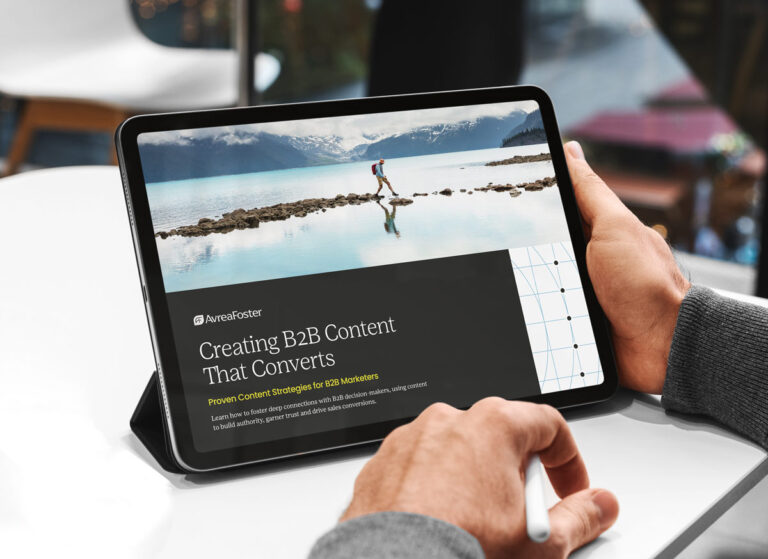Your B2B website is a living (and actively aging) asset.
“Websites are important for modern businesses” is not an innovative statement. At this point, it’s an inarguable truth. Despite the ubiquity of complex, content-rich websites in the B2B space, companies still feel uncertainty when it comes time to make changes that go beyond a tweak or minor adjustment.
The question of whether to rebuild or refresh a corporate website is more nuanced than it sounds. “Does the website mostly meet our needs? Yes? Then why would we tear it down?” Well, it just isn’t that simple, nor is it purely about what the average visitor sees on the surface.
Websites cannot be thought of the same way as the other sales and marketing assets in an organization’s arsenal. For one, B2B websites are vast in the quantity and depth of their content, both vertically and horizontally. They’re also tapestries of code, infinitely more complex in their construction than other pieces of material. After all, code ages and websites have to be nurtured. Lastly, and maybe most importantly, websites are evergreen and users interact with them at all stages of the buyer’s journey, on all kinds of devices and at all times of day.
What’s the difference between a rebuild and a refresh?
A rebuild consists of using this website inflection point to start from a blank slate and approach your B2B organization’s digital experience holistically. Even if the user-facing output is similar, major changes can be undertaken behind the scenes to future-proof, improve site speed, make the backend more usable, add new functionality and more. We’ll get into all of these topics in a moment.
A refresh is all about minor adjustments. You’re not building a new house; you’re putting up new wallpaper and, at most, knocking out a wall or two. This is more than just updating some verbiage here and there and A/B testing some CTA button colors, but it typically doesn’t involve massive code changes or major adjustments to architecture and functionality.
When is it appropriate to rebuild?
Since it’s the more intensive of the two paths we’re discussing, it would be easy to assume that starting from scratch on your organization’s B2B website should be considered a last resort — that you only rebuild when refreshing is no longer tenable.
That’s actually pretty far from the case, and it’s incumbent upon a B2B business to overhaul their web presence proactively rather than reactively.
Put another way, you wouldn’t wait until your car breaks down to trade it in for something new. Needs change incrementally. Similarly, you don’t want to wait until your website is unresponsive or has a zero conversion month before you consider replacing it.
Common factors that warrant a rebuild include:
01
your B2B website is over 5 years old.
Half a decade in the world of web design and development can translate to exponential change. CMS overhauls, digital tools entering or leaving the scene, SEO algorithm updates, accessibility standards and much more can change, and that doesn’t even factor in your business or the look of your website itself. These catalysts are 100% external.
To be clear, we aren’t saying every website over the age of 5 is ripe for the scrap heap — it’s more that this age milestone should prompt marketing teams to take a deeper look at their website and start charting the path forward, one way or another.
02
You are changing the CMS, have an unusable backend or an unsupported theme.
These technical issues all speak to the same overriding issue — the foundational backbone of your website is in disrepair. In some cases, despite the website looking fine from a user-facing standpoint, the CMS has become completely unusable for the business, meaning updates cannot be made. This isn’t an issue solvable by a developer pushing updates while your site is live. Issues like these require a fresh build.
Theoretically, you could execute the same web design a second time with new code supporting it, but these issues typically correspond to that 5-year milestone we just discussed.
03
Your business has undergone a rebrand.
We’re not talking about a new logo; we’re talking about an entirely new B2B brand. That means (in addition to a new logo) new colors, visual language, messaging, photography style and illustration style. Making one or two of these changes to an existing site is feasible in a light refresh, but when all or most of these attributes have undergone change, it’s recommended that you seize the opportunity to put your website through the same overhaul.
For many members of your target audience, the website may be their first major touchpoint with your brand. For that reason, it’s vitally important that your website act as an extension of the new brand rather than simply respond to it.
04
Your B2B website has poor mobile performance, load speeds or accessibility scores.
This particular situation directly impacts the user experience in ways some of the previous issues do not. If your website does not respond well for mobile users or is not loading at all, regardless of device, that can make or break website success. All three of these factors go beyond user experience quality and have a direct and meaningful impact on SEO health as well.
While there are steps that can be taken to make moderate improvements to these qualities, much more serious improvement requires a rebuild from the ground up — particularly as it relates to mobile responsiveness. As a note, mobile users make up at least 20-35% of B2B website visitors.
05
Your business has experienced structural changes that impact website architecture.
Not all major strategic changes within a B2B organization require equally large website adjustments, but those that impact the presentation of services and products typically do.
In this case, we’re not talking about adding a new service or adjusting a product description; we’re referring to the addition or subtraction of entire business units on a site that allows for the easy addition of templated page types. The situation we’re speaking to often follows a merger or acquisition, or a sea change within an organization. In other words, you know when a shift of this caliber has happened and the built-in architecture of your existing website is unlikely to be able to handle the scale of changes required.
For a recent AvreaFoster example of the rebuild approach in practice, take a look at our case study for Arrive Health. There, we took their digital experience back to the strategic foundation and built something wholly new to better support their audiences and goals.
When is it appropriate to refresh?
The majority of the time when B2B website changes are warranted, this direction is the first line of thinking. There is the assumption that it’s more cost-effective (more on that later), and most professionals who don’t live in the world of web design don’t completely understand the limitations of an existing website backend.
That said, there are plenty of scenarios when a refresh is the right solution for the problem. The list of needs that could warrant a refresh is essentially endless, so we’ll focus on those that are a bit more intensive but still don’t call for a full rebuild.
Common factors that warrant a refresh include:
01
Your B2B website is less than 3 years old.
02
Your B2B website needs conversion optimization updates.
In most cases, the edits required to optimize for conversions are rudimentary. Unearthing the insight and making the correct strategic choices is complicated, but executing those changes is comparatively straightforward.
The whole point of A/B testing and monitoring user paths through a digital experience is to quickly respond to trends and make appropriate adjustments — that’s precisely what a minor website refresh is for.
03
Your B2B website requires SEO updates.
The majority of maintenance-level SEO updates are done without touching code and without impacting the user-facing version of the website. Making updates to page titles, meta descriptions, headline tagging and alt text can all happen without requiring major website changes.
04
Your B2B website features outdated or incomplete content.
Most B2B websites are built based on templated page designs, whether it was a completely custom design or used a website template as a starting point. For that reason, adding new pages or modules of pages is a pretty simple process and may not always require the intervention of a developer.
In some cases, the content of a page needs substantial edits. In other cases, whole new pages need to be added. Regardless, a competently built website should be able to accommodate these changes with ease.
For a recent AvreaFoster example of the refresh approach in practice, take a look at our work for New Benefits. There, we seamlessly integrated an updated brand and refined messaging in a manner that visibly transformed the website without requiring us to start from scratch.
Let’s talk about pricing.
It would seem, based on the factors we’ve just discussed, that a B2B website refresh is a less time-consuming, less expensive process for a business. While that’s true a lot of the time, it’s not always the case. And choosing a refresh when a rebuild is what’s necessary can be an incredibly costly mistake.
First, we have to consider frequency. To use the car metaphor again, while replacing an individual part is significantly less expensive than buying a new car, there does come a point when the incremental costs are stacking up. Eventually, those costs eclipse the price of buying new and you’re left in a worse-off position because you waited.
That holds up well when considering a B2B website, but there is another layer of expense to consider: the opportunity cost of missed conversions. When you consider putting off a website rebuild, you can’t just compare the price of a new site versus the price of a facelift. You have to also consider the potential conversion rate improvement your new website could provide your business. If there is a gap between a rebuild and a major refresh, opportunity cost almost always closes it.
What is the line between a rebuild and a refresh?
For us, it comes down to a handful of things: the effort required to integrate the brand into the user experience, the changes required to support successful digital marketing strategies, and the degree of web developer involvement required across the board.
While it’s common for a simple website refresh to involve light editing or addition of code, as soon as the factors mentioned above enter the fray and large-scale overhauling under the hood is demanded, a rebuild is always the more efficient and effective approach.
Boiled down to the most basic premise, it’s simpler, faster and more cost-effective to do something than it is to undo and then redo something. Two website refresh half-measures don’t add up to the full measure of creating a new website when the time is right.
Whether this information has brought your next site step into focus, or you’re still on the fence between a rebuild and a redesign, we’re here to help. Reach out to the AvreaFoster team and start charting a course to a more impactful B2B website today.



